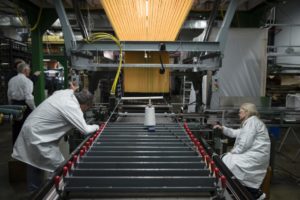
Workers manufacture thermal protection systems for NASA at Bally Ribbon Mills in Bally, Pa. (AP Photo/Matt Rourke, File)
WASHINGTON (AP) — U.S. employers pulled back on hiring in May by adding only 138,000 jobs, though the gains were enough to help nudge the unemployment rate down to a 16-year low.
The Labor Department said Friday that the jobless rate fell to 4.3 percent, the lowest level since 2001, from 4.4 percent. Still, the rate declined mainly for a less-than-encouraging reason: People stopped looking for work in May and so were no longer counted as unemployed.
The government’s report suggested that eight years into the recovery from the Great Recession, job growth may be slowing after a long stretch of robust gains. Besides the hiring slowdown in May, the government on Friday revised down its estimate of job growth in March and April by a combined 66,000. Monthly job gains have averaged 121,000 over the past three months, compared with 181,000 over the past 12 months.
Employers are now choosing from among a smaller pool of job applicants, and some are having trouble finding people with the skills they need. Average hourly earnings have risen a middling 2.5 percent over the past year.
“Given reports that job openings are near all-time highs, it suggests that businesses are struggling to fill these positions,” said Beth Ann Bovino, U.S. chief economist for S&P Global Ratings.
Still, most analysts think job growth is solid enough for the Federal Reserve to feel confident enough to raise interest rates again when it meets in two weeks.
And there were some bright spots in May’s jobs report. Restaurants and health care companies posted solid gains. Food services added 30,300 workers, health care 24,300. Construction added 11,000. As energy prices stabilize somewhat, the mining sector — which includes oil, natural gas, coal and metal ore — added 6,600 jobs.
But governments, manufacturers and retailers lost workers.
Governments shed 9,000 workers, with the losses concentrated at the state and local level. Manufacturers let go of 1,000. Retailers trimmed their ranks by 6,100.
Despite the slowdown in job growth, the U.S. economy is running neither too hot nor too cold, with growth holding at a tepid but far from recessionary 2 percent annual rate. Few economists foresee another downturn looming, in part because the recovery from the recession has been steady but grinding, with little sign of the sort of overheated pressures that normally trigger a recession.
The government’s monthly jobs report produces a net gain by estimating how many jobs were created and comparing that figure with how many it estimates were lost. If hiring maintains its current pace, it would exceed population growth, and the unemployment rate should eventually fall even further below its current 4.3 percent, a level associated with a healthy economy.
An influx of job seekers can inflict a drag on pay growth. As more people start seeking jobs, employers begin to have less incentive to raise pay. It’s only when employers face a shallow pool of job applicants that they tend to feel compelled to raise pay in hopes of hiring people who fit their needs.
For now, some companies that are hiring have no plans to raise pay much. One of them is Atlanta-based Workout Anytime Companies, which runs 24-hour-a-day gyms. It plans to open 47 franchises before year’s end, adding more than 400 jobs.
But because most of its positions are entry-level jobs geared for younger workers, the company has been able to pay them in part through bonuses rather than hourly raises.
“We’re not seeing a lot of upward pressure on hourly wages,” said Mark de Gorter, the company’s chief operating officer.
Annual growth in average hourly earnings has been so-so in recent months. And whatever meaningful pay raises that exist are going disproportionately to managers and supervisors.
Pay gains may be weak in part because one crucial ingredient for economic growth — worker productivity — has been sluggish. Workers generally enjoy higher incomes once they generate more value per hour on the job. But productivity fell 0.6 percent in the first three months of 2017, coming after persistent weakness in previous years.
“There is not going to be a big turnaround in wage growth until productivity picks up,” said Andrew Chamberlain, chief economist at the jobs site Glassdoor.
Other economists suggest that meaningful pay gains tend to occur after a lag and that the low 4.3 percent unemployment rate will lead to higher wages over the next 12 to 18 months.
“We would be surprised if wages were still running under 3 percent, for example, when we get to the end of 2018,” said Chris Rupkey, managing director at MUFG Union Bank.
Many of the jobs that have been added over the past year are in the generally lower-paying leisure and hospitality industry — hotels, restaurants and amusement parks.
The Trump administration has designated the pace of hiring for good-paying skilled jobs in construction, manufacturing and mining as among the categories it monitors for economic health. Hiring in those three sectors has been comparatively sluggish over the past year.


